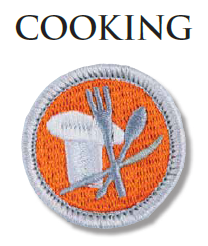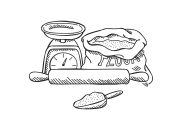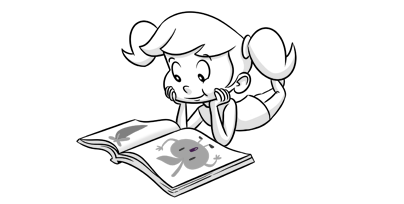Cooking Merit Badge Health & Safety
[text-box width=”100%” align=”center”]

[unordered title=”Areas of Study:”] [line]Health and Safety[/line] [line]Nutrition[/line] [line]Cooking Basics[/line] [line]Cooking at Home[/line] [line]Camp Cooking[/line] [line]Trail and Backpacking meals[/line] [line]Food related careers[/line] [/unordered] [/text-box] [div-line] [text-box]
Burns and Scalds
1st degree burns are superficial burns and are caused by touching hot items. There is a painful reddening of the skin and the burn is only on the outer layer of skin.
[unordered title=”Treatment:”] [line]Step 1 – move the victim to safety away from any source of danger.[/line] [line]Step 2 – Cool the burn. Hold the burn under cold water or apply a cool, wet compress until the pain eases. [/line] [line]Step 3 – Cover the burn. [/line] [/unordered]Allow the burn to dry, then cover loosely with sterile gauze pad and bandage. Superficial burns do not usually need more medical attention until they affect more than 20 to 25 percent of the body.
2nd degree burns affect the outer layer of skin and part of the layer below it. These burns develop redness and blistering of the skin. These are caused by scalding from boiling liquids.
Treatment: follow the same steps for a 1st degree burn, however the victim may choose to seek medical attention when he/she can.
3rd degree burns are also called full-thickness burns and these are serious and possibly life threatening. These are caused by being exposed to open flames, electricity, or chemicals creating such a burn. The skin may be burned away and the flesh charred. If nerves are damaged, the victim may not feel any pain.
[unordered title=”Treatment:”] [line]Step 1 – move the victim to safety away from any source of danger.[/line] [line]Step 2 – unless there is difficulty breathing have the victim lie down. Raise the burn level above the victim’s heart if possible,and protect the victim from drafts.
** Do not remove any clothing, as it may be sticking to the victim’s flesh.[/line] [line]Step 3 – Cool the burn. Hold the burn under cold water or apply a cool, wet compress until the pain lessens.[/line] [line]Step 4 – After cooling the burn, cover the area with sterile dressings, treat for shock and seek immediate medical attention.[/line] [/unordered]
** If 3rd degree burns affect breathing, the head, neck, hands, feet or torso seek immediate treatment.
[unordered title=”Always get immediate medical treatment if the victim has:”] [line]Trouble breathing[/line] [line]Burns that cover more than one body part or a large surface[/line] [line]Burns that may have affected the airway (mouth and nose)[/line] [line]Any 2nd or 3rd degree burns that affect the head, neck, hands, feet, or torso[/line] [line]Any victim with 3rd degree burns and is younger than 5 or older than 60[/line] [line]Burns from chemicals, explosions, or electricity![/line] [/unordered] [/text-box]


